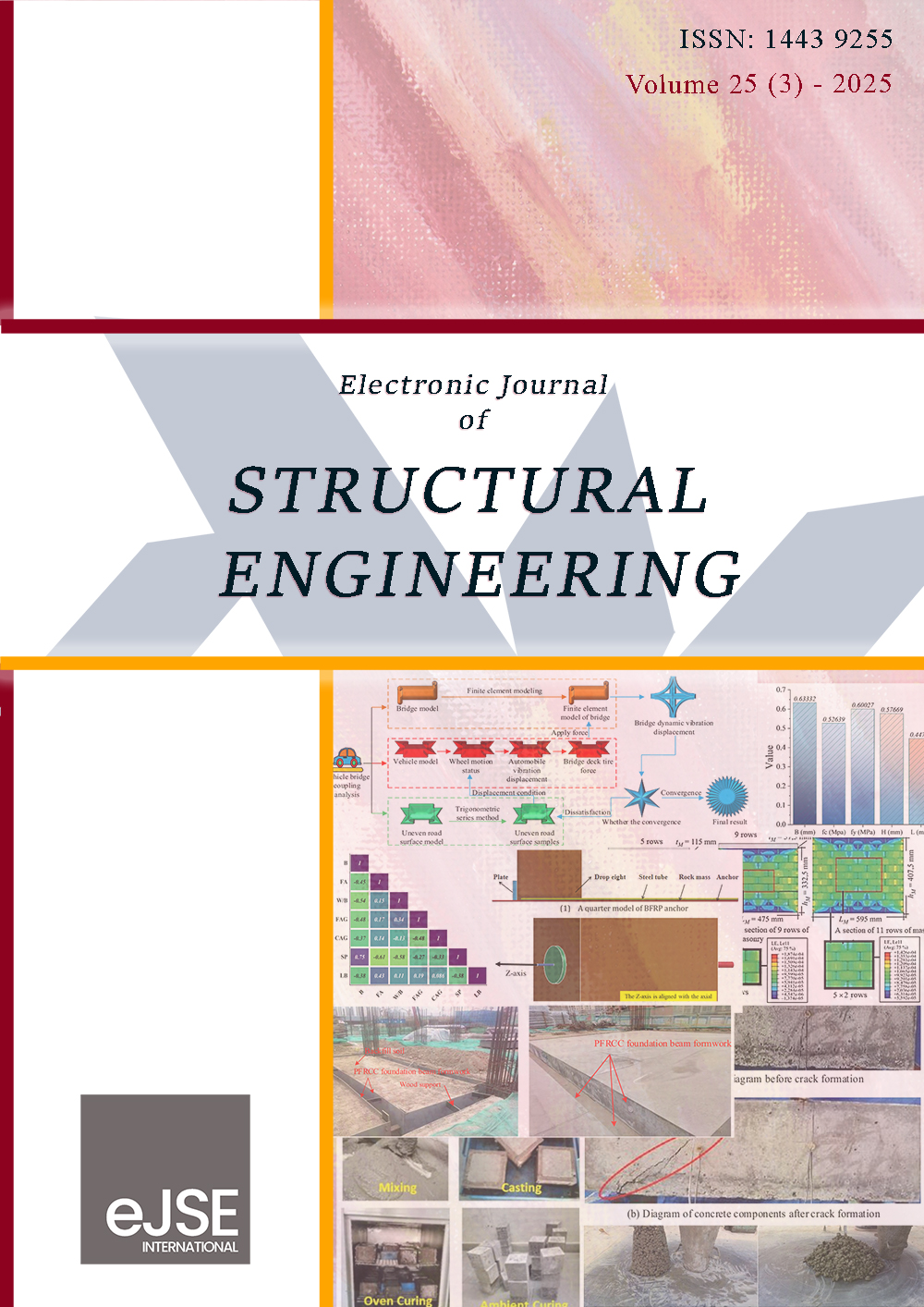Heat and abrasion resistance of fly ash geopolymer mortar comprising ceramic polishing waste and cured with different conditions
DOI:
https://doi.org/10.56748/ejse.24766Keywords:
Fire resistance, Abrasion wear, Ceramic polishing waste, Microstructure, Ambient curing, Temperature curingAbstract
The rising demand for geopolymer concrete (GPC) is associated with its lower environmental impact. GPC has significant potential for the use of industrial by-products as a geopolymer precursor. The vitrified and wall tile polishing processes produce two types of ceramic polishing wastes (CPWs): vitrified tile CPW (VCPW) and wall tile CPW (WCPW). In this study, fly ash (FA), CPW, and alkaline activators were used to make geopolymer mortar (GM). This study investigates the heat and abrasion resistance of GM cured under three curing conditions (ambient, 60°C for 24 hours, and 60°C for 48 hours). The microstructure after heat exposure was analyzed by scanning electron microscopy (SEM). In addition, the GM samples were tested for surface abrasion and compressive strength. The outcomes revealed that replacing FA with 15% CPWs improves early-age compressive strength and abrasion resistance and provided similar performance in heat resistance at 1000°C. The curing conditions strongly influenced early-age compressive strength and fire exposure performance at 500°C. The microstructure of the geopolymer shows additional geopolymerization due to heat exposure and reduced degradation of the gel. Replacing FA with 15% VCPW or WCPW enhances the heat and abrasion resistance of GM.
Downloads
References
Abadel, A.A. and Alghamdi, H. (2023) ‘Effect of high volume tile ceramic wastes on resistance of geopolymer mortars to abrasion and freezing-thawing cycles: Experimental and deep learning modelling’, Ceramics International, 49(10), pp. 15065–15081. DOI: https://doi.org/10.1016/j.ceramint.2023.01.089
Abd Razak, S.N. et al. (2022) ‘Fire performance of fly-ash-based geopolymer concrete: Effect of burning temperature on mechanical and microstructural properties’, Materials Today: Proceedings, 66, pp. 2665–2669. DOI: https://doi.org/10.1016/j.matpr.2022.06.491
Ahmed, J.K., Atmaca, N. and Khoshnaw, G.J. (2024) ‘Exploring flexural performance and abrasion resistance in recycled brick powder-based engineered geopolymer composites’, Beni-Suef University Journal of Basic and Applied Sciences, 13(1). DOI: https://doi.org/10.1186/s43088-024-00532-7
Al-Hashem, M.N. et al. (2022) ‘Mechanical and Durability Evaluation of Metakaolin as Cement Replacement Material in Concrete’, Materials, 15(22). DOI: https://doi.org/10.3390/ma15227868
Aly, S.T. et al. (2018) ‘Properties of Ceramic Waste Powder-Based Geopolymer Concrete’, International Congress on Polymers in Concrete (ICPIC 2018). Edited by M.M.R. Taha, pp. 429–435. DOI: https://doi.org/10.1007/978-3-319-78175-4_54
Belaïd, F. (2022) ‘How does concrete and cement industry transformation contribute to mitigating climate change challenges?’, Resources, Conservation & Recycling Advances, 15, p. 200084. DOI: https://doi.org/10.1016/j.rcradv.2022.200084
Bhavsar, J.K. and Panchal, V. (2022) ‘Ceramic Waste Powder as a Partial Substitute of Fly Ash for Geopolymer Concrete Cured at Ambient Temperature’, Civil Engineering Journal (Iran), 8(7), pp. 1369–1387. DOI: https://doi.org/10.28991/CEJ-2022-08-07-05
Bingöl, Ş. et al. (2020) ‘Durability Properties of Geopolymer Mortars Containing Slag’, Iranian Journal of Science and Technology - Transactions of Civil Engineering, 44(0123456789), pp. 561–569. DOI: https://doi.org/10.1007/s40996-019-00337-0
Chindaprasirt, P. et al. (2010) ‘High-strength geopolymer using fine high-calcium fly ash’, Journal of Materials in Civil Engineering, 23(3), pp. 264–270. DOI: https://doi.org/10.1061/(ASCE)MT.1943-5533.0000161
Davidovits, J. (1994) ‘Properties of geopolymer cements’, in First international conference on alkaline cements and concretes, pp. 131–149.
Degirmenci, F.N. (2018) ‘Freeze-Thaw and fire resistance of geopolymer mortar based on natural and waste pozzolans’, Ceramics - Silikaty, 62(1), pp. 41–49. DOI: https://doi.org/10.13168/cs.2017.0043
Dissanayake, D.M.H., Dissanayake, D.M.A.K. and Pathirana, C.K. (2022) ‘Strength properties of Fly Ash based Geopolymer Concrete cured at different temperatures’, Electronic Journal of Structural Engineering, 22(2), pp. 19–26. DOI: https://doi.org/10.56748/ejse.223262
El-Dieb, A.S. et al. (2018) ‘Ceramic waste powder: from landfill to sustainable concretes’, Proceedings of the Institution of Civil Engineers - Construction Materials, 171(3), pp. 109–116. DOI: https://doi.org/10.1680/jcoma.17.00019
Ezzedine El Dandachy, M. et al. (2024) ‘Effect of Elevated Temperatures on Compressive Strength, Ultrasonic Pulse Velocity, and Transfer Properties of Metakaolin-Based Geopolymer Mortars’, Buildings, 14(7), p. 2126. DOI: https://doi.org/10.3390/buildings14072126
Hager, I., Sitarz, M. and Mróz, K. (2021) ‘Fly-ash based geopolymer mortar for high-temperature application – Effect of slag addition’, Journal of Cleaner Production, 316. DOI: https://doi.org/10.1016/j.jclepro.2021.128168
Hassan, A. et al. (2023) ‘Fire resistance characteristics of geopolymer concrete for environmental sustainability: a review of thermal, mechanical and microstructure properties’, Environment, Development and Sustainability, 25(9), pp. 8975–9010. DOI: https://doi.org/10.1007/s10668-022-02495-0
Hassan, A., Arif, M. and Shariq, M. (2019) ‘Effect of curing condition on the mechanical properties of fly ash-based geopolymer concrete’, SN Applied Sciences, 1(12), pp. 1–9. DOI: https://doi.org/10.1007/s42452-019-1774-8
Herbudiman, B. et al. (2024) ‘Effect of Different Ceramic Waste Powder on Characteristics of Fly Ash-Based Geopolymer’, Civil Engineering Journal (Iran), 10(02), pp. 431–443. DOI: https://doi.org/10.28991/CEJ-2024-010-02-06
Huseien, G.F. et al. (2018) ‘Waste ceramic powder incorporated alkali activated mortars exposed to elevated Temperatures: Performance evaluation’, Construction and Building Materials, 187, pp. 307–317. DOI: https://doi.org/10.1016/j.conbuildmat.2018.07.226
IS 15658 (2006) Indian Standard Precast Concrete Blocks For Paving — Specification. Bureau of Indian Standards.
IS 383:2016 (2016) ‘Indian Standard Specification for Coarse and Fine Aggregates from Natural Sources for Concrete, Bureau of Indian Standards, New Delhi.
Joshi, S. V. and Kadu, M.S. (2012) ‘Role of Alkaline Activator in Development of Eco-friendly Fly Ash Based Geo Polymer Concrete’, International Journal of Environmental Science and Development, (January 2012), pp. 417–421. DOI: https://doi.org/10.7763/IJESD.2012.V3.258
Kalinowska-Wichrowska, K. et al. (2024) ‘Properties of Geopolymer Mixtures Incorporating Recycled Ceramic Fines’, Materials, 17(8). DOI: https://doi.org/10.3390/ma17081740
Kaya, M. et al. (2018) ‘Behaviour of geopolymer mortars after exposure to elevated temperatures’, Medziagotyra, 24(4), pp. 428–436. DOI: https://doi.org/10.5755/j01.ms.24.4.18829
Kaya, M (2022) ‘Magazine of Civil Engineering Mechanical properties of ceramic powder based geopolymer mortars’, 112(11207), pp. 20–22.
Kaya, Mehmet (2022) ‘The effect of micro-SiO2 and micro-Al2O3 additive on the strength properties of ceramic powder-based geopolymer pastes’, Journal of Material Cycles and Waste Management, 24(1), pp. 333–350. DOI: https://doi.org/10.1007/s10163-021-01323-3
Krishna Rao, A. and Kumar, D.R. (2020) ‘Effect of various alkaline binder ratio on geopolymer concrete under ambient curing condition’, Materials Today: Proceedings, 27, pp. 1768–1773. DOI: https://doi.org/10.1016/j.matpr.2020.03.682
Memiş, S. and Bılal, M.A.M. (2022) ‘Taguchi optimization of geopolymer concrete produced with rice husk ash and ceramic dust’, Environmental Science and Pollution Research, 29(11), pp. 15876–15895. DOI: https://doi.org/10.1007/s11356-021-16869-w
Nayana, A.M. and Rakesh, P. (2018) ‘Strength and durability study on cement mortar with ceramic waste and micro-silica’, Materials Today: Proceedings, 5(11, Part 3), pp. 24780–24791. DOI: https://doi.org/10.1016/j.matpr.2018.10.276
Negahban, E., Bagheri, A. and Sanjayan, J. (2023) ‘Investigation of abrasion resistance of geopolymer concrete cured in ambient temperature for pavement applications’, Road Materials and Pavement Design, 24(11), pp. 2641–2662. DOI: https://doi.org/10.1080/14680629.2022.2161934
Patel, H., Arora, N.K. and Vaniya, S.R. (2015) ‘Use of ceramic waste powder in cement concrete’, International Journal for Innovative Research in Science & Technology, 2(1), pp. 91–97.
Phul, A.A. et al. (2019) ‘GGBS And Fly Ash Effects on Compressive Strength by Partial Replacement of Cement Concrete’, Civil Engineering Journal (Iran), 5(4), pp. 913–921. DOI: https://doi.org/10.28991/cej-2019-03091299
Ramujee, K. and Potharaju, M. (2014) ‘Permeability and abrasion resistance of geopolymer concrete’, Indian Concrete Journal, 88(12), pp. 34–43.
Rashad, A.M. and Essa, G.M.F. (2020) ‘Effect of ceramic waste powder on alkali-activated slag pastes cured in hot weather after exposure to elevated temperature.’, Cement and Concrete Composites, 111, p. 103617. DOI: https://doi.org/10.1016/j.cemconcomp.2020.103617
Raval, A.D., Patel, D.I.N. and Pitroda, J. (2013) ‘Ceramic waste: Effective replacement of cement for establishing sustainable concrete’, International Journal of Engineering Trends and Technology (IJETT), 4(6), pp. 2324–2329.
Runganga, D., Okonta, F. and Musonda, I. (2024) ‘Strength and Durability Properties of High-Volume Fly Ash (HVFA) Binders: A Systematic Review’, CivilEng, 5(2), pp. 435–460. DOI: https://doi.org/10.3390/civileng5020022
Saranya, P., Nagarajan, P. and Shashikala, A.P. (2019) ‘Development of Ground-Granulated Blast-Furnace Slag‑Dolomite Geopolymer Concrete’, ACI Materials Journal, 116(6), pp. 235–243. DOI: https://doi.org/10.14359/51716981
Sarker, P.K., Kelly, S. and Yao, Z. (2014) ‘Effect of fire exposure on cracking, spalling and residual strength of fly ash geopolymer concrete’, Materials and Design, 63, pp. 584–592. DOI: https://doi.org/10.1016/j.matdes.2014.06.059
Saxena, R. and Gupta, T. (2022) ‘Assessment of mechanical, durability and microstructural properties of geopolymer concrete containing ceramic tile waste’, Journal of Material Cycles and Waste Management, 24(2), pp. 725–742. DOI: https://doi.org/10.1007/s10163-022-01353-5
Singh, N.B. (2018) ‘Fly ash-based geopolymer binder: A future construction material’, Minerals, 8(7). DOI: https://doi.org/10.3390/min8070299
Tuyan, M., Andiç-Çakir, Ö. and Ramyar, K. (2018) ‘Effect of alkali activator concentration and curing condition on strength and microstructure of waste clay brick powder-based geopolymer’, Composites Part B: Engineering, 135, pp. 242–252. DOI: https://doi.org/10.1016/j.compositesb.2017.10.013
Vilas Meena, R. et al. (2022) ‘“Impact of waste ceramic tile on resistance to fire and abrasion of self-compacting concrete”’, Materials Today: Proceedings, 60, pp. 167–172. DOI: https://doi.org/10.1016/j.matpr.2021.12.287
Witzke, F.B. et al. (2023) ‘Abrasion resistance of metakaolin-based geopolymers through accelerated testing and natural wear’, Wear, 530–531, p. 204996. DOI: https://doi.org/10.1016/j.wear.2023.204996
Wong, L.S. (2022) ‘Durability Performance of Geopolymer Concrete: A Review’, Polymers, 14(5). DOI: https://doi.org/10.3390/polym14050868
Yanti, E.D. et al. (2024) ‘Utilization of various ceramic waste as fine aggregate replacement into fly ash-based geopolymer’, Materials Letters, 357, p. 135651. DOI: https://doi.org/10.1016/j.matlet.2023.135651
Yılmaz, A., Degirmenci, F.N. and Aygörmez, Y. (2023) ‘Effect of initial curing conditions on the durability performance of low-calcium fly ash-based geopolymer mortars’, Boletin de la Sociedad Espanola de Ceramica y Vidrio [Preprint]. DOI: https://doi.org/10.1016/j.bsecv.2023.10.006
Zailani, W.W.A. et al. (2020) ‘Effect of Iron Oxide (Fe2O3) on the Properties of Fly Ash Based Geopolymer’, IOP Conference Series: Materials Science and Engineering, 877(1). DOI: https://doi.org/10.1088/1757-899X/877/1/012017
Zareei, S.A. et al. (2017) ‘Rice husk ash as a partial replacement of cement in high strength concrete containing micro silica: Evaluating durability and mechanical properties’, Case Studies in Construction Materials, 7(October 2016), pp. 73–81. DOI: https://doi.org/10.1016/j.cscm.2017.05.001
Zhang, G.Y. et al. (2021) ‘Effect of waste ceramic powder on the properties of alkali–activated slag and fly ash pastes exposed to high temperature’, Polymers, 13(21). DOI: https://doi.org/10.3390/polym13213797
Zhang, H. et al. (2020) ‘Deterioration of ambient-cured and heat-cured fly ash geopolymer concrete by high temperature exposure and prediction of its residual compressive strength’, Construction and Building Materials, 262, p. 120924. DOI: https://doi.org/10.1016/j.conbuildmat.2020.120924
Downloads
Published
How to Cite
Issue
Section
License
Copyright (c) 2025 Dr. Jay Bhavsar, Dr. Vijay Panchal

This work is licensed under a Creative Commons Attribution 4.0 International License.







